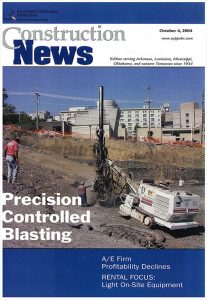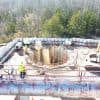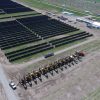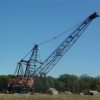PROJECT DETAILS
Just a few days after finishing the City Library Project for the City of Fayetteville, Dykon was contacted by Baldwin & Shell Construction Co., the construction managers for the University of Arkansas at Fayetteville, with a similar project. A multi-story parking facility had to be built in the heart of the University of Arkansas Campus, just across the street from the building that housed the Sam Walton College of Business.
 Adding yet another level of difficulty to this already formidable project was the fact that since the inception of the University of Arkansas in the late 1800’s, the use of drilling and blasting had never been permitted for rock removal on any project whatsoever. Before any Precision Controlled Blasting could be performed, the University officials had to be convinced it could be done safely, economically and on schedule.
Adding yet another level of difficulty to this already formidable project was the fact that since the inception of the University of Arkansas in the late 1800’s, the use of drilling and blasting had never been permitted for rock removal on any project whatsoever. Before any Precision Controlled Blasting could be performed, the University officials had to be convinced it could be done safely, economically and on schedule.
The Dykon Blasting Technical Team met with University officials to discuss the possibility and feasibility of lifting the University wide ban on rock blasting for this project. Safety to the students and surrounding public were of the utmost concern for the University officials. Secondary to that was the safety to University concerns such as the Physics Department, the Mechanical Department and the Business College. The Blasting could not be allowed to compromise public safety, property or ongoing academic activities.
The building of this parking deck required the excavation of nearly 40,000 cubic yards of rock underneath as much dirt for the leveling of the site for the building. Most of this material had to be hauled off site. The enormous amount of rock excavation coupled with the time-frame requirements for project completion made mechanical breakage of rock cost prohibitive. The cost of mechanical breaking of this rock in that stringent of a timeframe drove the projected cost of the project to amounts that threatened the feasibility of the Parking Deck altogether.
The first hurdle was to convince the University of Arkansas that the rock could be precisely drilled and blasted in a safe, timely and economical fashion. The second hurdle was to convince the University of Arkansas that Dykon Blasting was the right choice to perform this landmark project. The third hurdle was yet to come. It became apparent after several meetings with the University officials and the General Contractor, Baldwin and Shell, that Precision Controlled Blasting of rock would be allowed on this project and that Dykon Blasting was going to be the ones performing it for the university.
The blasting had to be scheduled for optimum safety to the public, minimal impact to the surrounding residents and university activities, not the least of which were ongoing laser research experiments being conducted in the physics lab. With this being the first Precision Controlled Blasting ever allowed on University projects and with the Physics Lab just across the street, ground vibration limits were imposed that reflected the University’s concerns for safety to adjacent properties. All eyes were focused on the blasting phase of this project. Five seismographs were used to monitor ground vibrations in several directions from each blast. Extensive preblasting surveys were used to document the existing conditions to all structures within a predetermined radius of the project. Shallow cuts and small shots were used to minimize the ground born vibrations. All the shots were covered with blankets of heavy blasting mats to eliminate the possibility of flying debris posing a safety hazard to pedestrians and property. Dual train horns were used on an established and published sequence to warn of an impending blasting event. Personnel were stationed at all access points and borders along the streets to watch for Pedestrians. Radio contact on a private channel was maintained constantly with the blaster in charge so that he knew when the site was secure of workers and pedestrians before initiating the final countdown for a blasting event.
The cooperation and tolerance of the general public and the University was remarkable. With this extra-ordinary support from the surrounding community, the University and all the onsite contractors, Dykon Blasting was able to complete the drilling and blasting successfully. We at Dykon Blasting cannot thank those who participated in the success of this project enough. The University, faculty, staff and students were cooperative and supportive to an unparalleled level. A special thanks goes out to Northwest Excavating, Baldwin & Shell Construction Co., and Rick Hamilton, construction coordinator for the U of A, for their cooperation and support.
Mr. Hamilton had this to say about the Precision Controlled Drilling and Blasting of this project after it’s completion:







